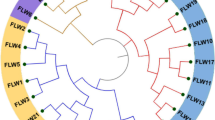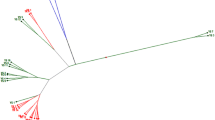Abstract
Alternaria black leaf spot disease of oilseed mustard is a primary cause of yield penalty not only in India but also throughout the world. To assess the degree of tolerance, 47 Indian mustard (Brassica juncea) genotypes were evaluated based on the performance against the causal pathogen Alternaria brassicicola. Genotypes were divided into six tolerance groups including resistant, highly tolerant, moderately tolerant, moderately susceptible, susceptible, and highly susceptible, keeping the nonhost resistant Sinapis alba as resistant control. Genotypes EC399312 and PAB-9511 were found to be the most tolerant. Fourteen morphological traits were evaluated which revealed considerable morphological variability among the genotypes. A number of seeds/siliqua and 1000 seed weight were positively correlated with yield per plant. Insignificant negative correlations had been found among plant height, days to maturity, and disease resistance with yield per plant. Correlation data indicate that seeds/siliqua and siliqua on the main shoot can be highly effective for higher grain yield. Genetic diversity of all genotypes was evaluated using simple sequence repeats (SSR) markers. The genotypes were evaluated for polymorphisms after amplification with 41 SSR primer pairs. Nineteen SSR markers in total were found to be highly informative with a polymorphic information content value > 0.50. The evaluation of genetic similarity and cluster analysis together with disease resistance provides some useful guides for assisting plant breeders in selecting suitable genetically diverse parents for the crossing program as well as for the development of mapping population.










Similar content being viewed by others
References
Anderson JA, Churchill GA, Autrique JE, Tanksley SD, Sorrells ME (1993) Optimizing parental selection for genetic linkage maps. Genome 36(1):181–186. https://doi.org/10.1139/g93-024
Doullah MAU, Meah MB, Okazaki K (2006) Development of an effective screening method for partial resistance to Alternaria brassicicola (dark leaf spot) in Brassica rapa. Eur J Plant Pathol 116(1):33–43. https://doi.org/10.1007/s10658-006-9035-2
Evanno G, Regnaut S, Goudet J (2005) Detecting the number of clusters of individuals using the software structure: a simulation study. Mol Ecol 14(8):2611–2620. https://doi.org/10.1111/j.1365-294X.2005.02553.x
Falush D, Stephens M, Pritchard JK (2003) Inference of population structure using multilocus genotype data: linked loci and correlated allele frequencies. Genetics 164:1567–1587
Gupta VP, Sekhon MS, Satija D (1991) Studies on genetic diversity, heterosis and combining ability in Indian mustard [Brassica juncea L. (Czern & Coss)]. Indian J Genet 51(4):448–453
Hopkins CJ, Cogan NOI, Hand M, Jewell E, Kaur J, Li X, Lim GAC, Ling AE, Love C, Mountford H, Todorovic M, Vardy M, Spangenberg GC, Batley J (2007) Sixteen new simple sequence repeat markers from Brassica juncea expressed sequences and their cross-species amplification. Mol Ecol Notes 7(4):697–700. https://doi.org/10.1111/j.1471-8286.2007.01681.x
Huangfu CH, Song XL, Qiang S (2009) ISSR variation within and among wild Brassica juncea populations: implication for herbicide resistance evolution. Genet Resour Crop Evol 56(7):913–924. https://doi.org/10.1007/s10722-009-9410-x
Joya SD, Shamsuddin AKM, Nath UK (2016) Genetic variability and characters associations in rapeseed (Brassica napus L.). Bangladesh J Pl Breed Genet 29(2):11–16
Kariola T, Brader G, Li J, Palva ET (2005) Chlorophyllase 1, a damage control enzyme, affects the balance between defense pathways in plants. Plant Cell 17(1):282–294. https://doi.org/10.1105/tpc.104.025817
Khan MA, Rabbani MA, Munir M, Ajmal SK, Malik MA (2008) Assessment of genetic variation within Indian mustard (Brassica juncea) germplasm using random amplified polymorphic DNA markers. J Integr Plant Biol 50(4):385–392. https://doi.org/10.1111/j.1744-7909.2007.00630.x
Kumar R, Gupta VP (1985) Isozyme studies in Indian mustard (Brassica juncea L.). Theor Appl Genet 70(1):107–110. https://doi.org/10.1007/BF00264491
Kumar B, Kolte SJ (2006) Development of Alternaria black leaf spot in genotypes of Indian mustard (Brassica juncea (L.) Czern.&Coss.) under field. Indian Phytopathol 59(3):314–317
Liu K, Goodman M, Muse S, Smith JS, Buckler E, Doebley J (2003) Genetic structure and diversity among maize inbred lines as inferred from DNA microsatellites. Genetics 165(4):2117–2128. https://doi.org/10.1007/s001220051632
Lowe AJ, Jones AE, Raybould AF, Trick M, Moule CL, Edwards KJ (2002) Transferability and genome specificity of a new set of microsatellite primers among Brassica species of the U triangle. Mol Ecol Notes 2:7–11. https://doi.org/10.1046/j.1471-8286.2002.00126.x
Mazumder M, Das S, Saha U, Chatterjee M, Bannerjee K, Basu D (2013) Salicylic acid-mediated establishment of the compatibility between Alternaria brassicicola and Brassica juncea is mitigated by abscisic acid in Sinapis alba. Plant Physiol Biochem 70:43–51. https://doi.org/10.1016/j.plaphy.2013.04.025
Meena PD, Awasthi RP, Chattopadhyay C, Kolte SJ, Kumar A (2010) Alternaria blight: a chronic disease in rapeseed-mustard. J Oilseed Brassica 1(1):1–11
Meena PD, Jambhulkar SJ, Gupta R, Meena HS, Singh D (2016) Rapid screening technique for alternaria blight resistance in Indian mustard (Brassica juncea L.) using cotyledonary leaf method. J Plant Pathol 98:463–469
Nowicki M, Nowakowska M, Niezgoda A, Kozik E (2012) Alternaria black spot of crucifers: symptoms, importance of disease, and perspectives of resistance breeding. Veg Crops Res Bull 76(1):5–19. https://doi.org/10.2478/v10032-012-0001-6
Piquemal J, Cinquin E, Couton F, Rondeau C, Seignoret E, Doucet I, Perret D, Villeger MJ, Vincourt P, Blanchard P (2005) Construction of an oilseed rape (Brassica napus L.) genetic map with SSR markers. Theor Appl Genet 111(8):1514–1523. https://doi.org/10.1007/s00122-005-0080-6
Pradhan AK, Sodhi YS, Mukhopadhyay A, Pental D (1993) Heterosis breeding in Indian mustard (Brassica juncea L. Czern & Coss): analysis of component characters contributing to heterosis for yield. Euphytica 69(3):219–229. https://doi.org/10.1007/BF00022368
Pratap P, Thakur AK, Meena PD, Meena HS, Sharma P, Singh D, Majumdar R (2015) Genetic diversity assessment in Indian mustard (Brassica juncea L) for Alternaria black leaf spot tolerance using SSR markers. J Oilseed Brassica 6(1):175–182
Pritchard JK, Stephens M, Donnelly P (2000) Inference of population structure using multilocus genotype data. Genetics 155:945–959
Ramchiary N, Hong CP, Dhandapani V (2011) Genic microsatellite markers in Brassica rapa: development, characterization, mapping, and their utility in other cultivated and Wild brassica relatives. DNA Res 18:305–320. https://doi.org/10.1093/dnares/dsr017
Sadaqat HA, Tahir MHN, Hussain MT (2003) Physiogenetic aspects of drought tolerance in canola (Brassica napus). Int J Agric Biol 5:611–614
Sarkar S, Ghosh S, Chatterjee M, Das P, Lahari T, Maji A, Mondal N, Pradhan KK, Bhattacharyya S (2011) Molecular markers linked with bruchid resistance in Vigna radiata var. Sublobata and their validation. J Plant Biochem Biotechnol 20(2):155–160. https://doi.org/10.1007/s13562-011-0039-4
Schlotterer C, Ritter R, Harr B, Brem G (1998) High mutation rate of a long microsatellite allele in Drosophila melanogaster provides evidence for allele-specific mutation rates. Mol Biol Evol 15(10):1269–274
Seidle E, Rude S, Petrie A (1995) The effect of Alternaria black spot of canola on seed quality and seed yield and studies on disease control. Agriculture and Agri-Food Canada, Saskatoon. https://doi.org/10.1136/adc.2006.104778
Suwabe K, Iketani H, Nunome T, Kage T, Hirai M (2002) Isolation and characterization of microsatellites in Brassica rapa L. Theor Appl Genet 104(6–7):1092–1098. https://doi.org/10.1007/s00122-002-0875-7
Turi NA, Farhat U, Rabbani MA, Shinwari ZK (2012) Genetic diversity in the locally collected Brassica species of Pakistan based on microsatellite markers. Pak J Bot 44(3):1029–1035
Vinu V, Singh N, Vasudev S, Yadava DK, Kumar S, Naresh S, Bhat SR, Prabhu KV (2013) Assessment of genetic diversity in Brassica juncea (Brassicaceae) genotypes using phenotypic differences and SSR markers. Revista de Biología Tropical (Int J Trop Biol Conserv) 61(4):1919–1934
Acknowledgments
We would like to acknowledge ICAR-Directorate of Rapeseed-Mustard Research, Bharatpur, Rajasthan, India, for providing seeds of the Brassica juncea genotypes. We acknowledge the contribution of Mr. Uttam Das, field assistant for maintaining the plants.
Funding
Funding for this study was provided by Women Scientist-A (WOS-A) scheme of Department of Science and Technology (DST), India.
Author information
Authors and Affiliations
Corresponding author
Additional information
Publisher's Note
Springer Nature remains neutral with regard to jurisdictional claims in published maps and institutional affiliations.
Rights and permissions
About this article
Cite this article
Ghosh, S., Mazumder, M., Mondal, B. et al. Morphological and SSR marker-based genetic diversity analysis of Indian mustard (Brassica juncea L.) differing in Alternaria brassicicola tolerance. Euphytica 215, 206 (2019). https://doi.org/10.1007/s10681-019-2523-1
Received:
Accepted:
Published:
DOI: https://doi.org/10.1007/s10681-019-2523-1




